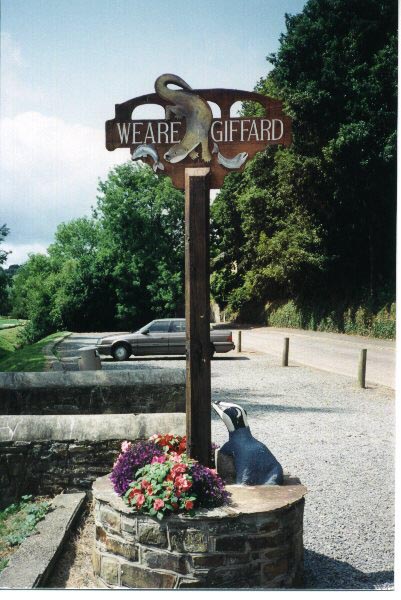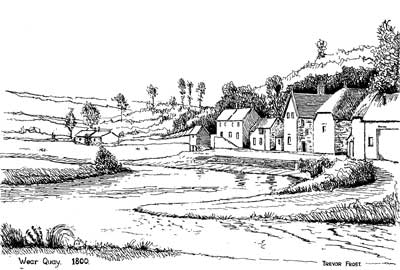Weare Giffard
 In 1803, Henry Brinsmead, from the St. Giles in the Wood Brinsmead family, but born in nearby Alverdiscott, married Elizabeth Beer. Elizabeth's family were long time residents of Weare Giffard. It is a pretty village straddling the North side of the Torridge River as it flows between Great Torrington and Bideford. Henry and Elizabeth had eleven children, some of whom left Devon for London and the growing piano manufacturing industry.
In 1803, Henry Brinsmead, from the St. Giles in the Wood Brinsmead family, but born in nearby Alverdiscott, married Elizabeth Beer. Elizabeth's family were long time residents of Weare Giffard. It is a pretty village straddling the North side of the Torridge River as it flows between Great Torrington and Bideford. Henry and Elizabeth had eleven children, some of whom left Devon for London and the growing piano manufacturing industry.
The sign to the right identifies Weare Giffard as a part of the Tarka Trail which provides a delightful walking path through North Devon. It follows a similar path to the Rolle Canal and the Railway line that followed after the canal.
Henry and Elizabeth were not just prolific but apparently quite well off and industrious. The Brinsmeads ran a public house in the Village called the Anchor, sometimes the Blue Anchor in the 1820's. It is no longer standing. It is said to have been shut down, along with other public houses, as a result of poaching for salmon in the river. The Brinsmead family also farmed at the far north end of the village at a farm called Allspill. There they also burnt lime, which was used in Bideford to paint the famous white houses, and also exported to Wales. The Brinsmead kilns and can still be seen.
 Wear Quay in 1800. Click for a large scale printable copy
Wear Quay in 1800. Click for a large scale printable copy
Weare Quay is simply a part of Weare Giffard village. In earlier times, the quay played a major part in the life of the village since the river could be navigated from Bideford down to Weare Giffard. Later, with the building of the Rolle Canal, boats could carry goods down further to Great Torrington. For 32 years, Robert Brinsmead was the managing clerk on the Canal. See the article in The North Devon Journal.
Weare Giffard Churchyard
Weare Giffard was the home of the Giffard family, who lived in the village from at least as early as 1130. In the late 1400's it was inhereted by the Fortescue family. Holy Trinity Church is located immediatly adjacent to Weare Hall, and is the final resting place for several Brinsmeads. The gravestones, although they have been moved to the side, are still there.
